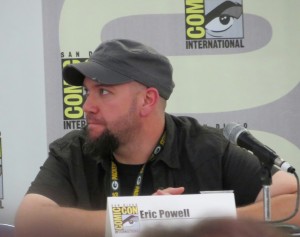 Editor’s Note: This article was written last night at around midnight Pacific time. It is only being uploaded now because the Internet access I paid my hotel $14 for was unable to keep a connection, what with everyone being back from the convention and presumably watching the hell out of Netflix on their iPads. The annual San Diego WiFi drought has begun in earnest.
Editor’s Note: This article was written last night at around midnight Pacific time. It is only being uploaded now because the Internet access I paid my hotel $14 for was unable to keep a connection, what with everyone being back from the convention and presumably watching the hell out of Netflix on their iPads. The annual San Diego WiFi drought has begun in earnest.
I have attended San Diego Comic-Con for the past eight years, and today I saw cracks occur that I never remember seeing at previous conventions. First, there were the trains. The railroad tracks run right down the middle of the road in front of the San Diego Convention Center, and you learn pretty quickly to hear, then grow annoyed by, and then ignore the constant clanging of the trolley bells. The air horn of the freight trains, not so much, but the point is that generally, the trains are a loud and short term annoyance.
Generally, but not today. Both at lunchtime and at at 7 p.m. – prime time for people to be leaving the convention center – long-ass freight trains pulled up in front of the convention center and just fucking stopped. Thus blocking off the primary route between the center and the Gaslamp Village, where all the restaurants and half the hotels are, and turning the area in front of the intersection into a human clusterfuck so bumbling and useless that, if any of the local cosplayers were actually aliens, they would report to their overlords that the human race deserved to be wiped out like a termite nest.
Now I am not under any illusions that the people behind SDCC have any control over the schedule or driving of freight trains. But they do have some control over the clearing of rooms and the start times of panels, and of the three we attended today, two of them started late. With the earlier Avatar Comics panel (which I will likely write about tomorrow), the volunteer line wrangler told us that the panelists were delayed and at least kept us informed… while still preventing us from entering the room so we could sit the hell down.
But with the panel regarding the Kickstarter work on the proposed movie version of The Goon, no one told us a Goddamned thing. They lined us up in a weird accordion pattern, and when they realized that it was a much larger crowd than anyone anticipated (which seems a little odd; the project pulled in nearly half a million dollars on Kickstarter, which, since The Goon is a little indie comic, should indicate that the movie version has a little interest behind it), one of the volunteers tried to get people who intended to stay through the Goon panel into the following panel to split off into a different line, which is truly unprecedented in my SDCC experience… or at least it would have been if anyone paid any Goddamned attention at all to the poor, deluded dingbat. After all, Comic-Con runs on the ability of the truly obsessed to park in a panel room all day if they want to to see something in particular. Had someone implied that people waiting for a particular panel wait in a separate line until that particular panel started say, last year outside of Hall H, they would have found the guy floating face-down in the bay with his volunteer badge choked around his nuts and “Team Jacob” hammered into the flesh of his forehead.
So instead, we all waited in the same line until someone’s shit was finally gotten together at about 6:10 p.m. – ten minutes after the scheduled panel start time. Once inside, we waited another five minutes (my notes read, “Fifteen minutes late – this is not the Superman movie panel, motherfucker”) until The Goon creator Eric Powell, computer animation studio Blur Studios co-owner Tim Miller, and Blur Studios Animator / Director Jeff Fowler took the stage, to the side of a screen showing the world’s most simplistic Samsung DVD player main menu screen.
And where most movie panels open with some hype guy whipping the crowd into a frenzy, this one opened with Powell saying, “Since this is a Goon movie…” and cracking open a can of beer, “That Kickstarter is a hell of a drug.”
Yeah, this panel was not your average SDCC movie hype machine. Which makes sense, considering it is drumming up publicity for a movie that has been in development for five years, and still exists only as a dream that was given life support by a crowdfunding drive only strong enough to create a black and white animatic story reel, all in the hopes of attracting a real movie studio’s attention.
Shit, I’d be drinking, too.
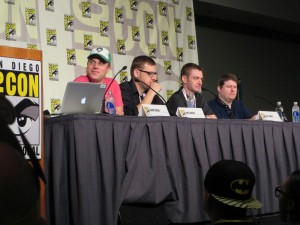 I have been hearing about DC Comics’s The Trinity War crossover for what feels like every week since DC launched the New 52 Reboot. God knows that DC wanted to tease the Goddamned thing right out of the gate, what with sticking Pandora (or, as we knew her at the time, “The Hooded Woman,” or perhaps, “The Obvious McGuffin,” and sometimes, “The Stalking Chick With Psoriasis Seriously What’s With The Hood Is She Hiding A Third Eye Or Some Kind Of Suppurating Nipple On Her Forehead” (at least in our Home Office).
I have been hearing about DC Comics’s The Trinity War crossover for what feels like every week since DC launched the New 52 Reboot. God knows that DC wanted to tease the Goddamned thing right out of the gate, what with sticking Pandora (or, as we knew her at the time, “The Hooded Woman,” or perhaps, “The Obvious McGuffin,” and sometimes, “The Stalking Chick With Psoriasis Seriously What’s With The Hood Is She Hiding A Third Eye Or Some Kind Of Suppurating Nipple On Her Forehead” (at least in our Home Office).

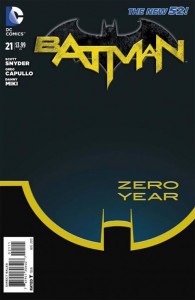
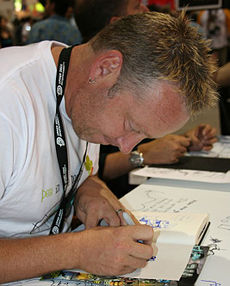
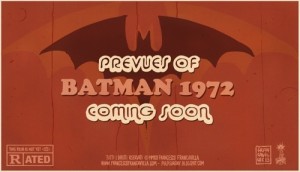

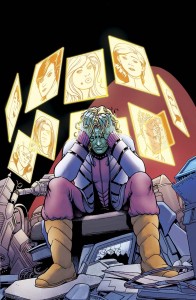
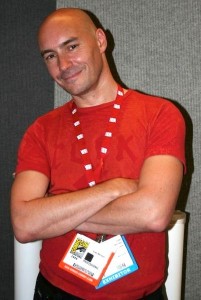
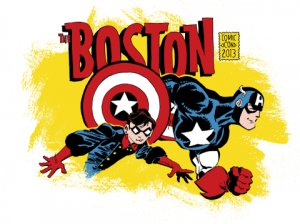
 Podcast RSS Feed
Podcast RSS Feed iTunes
iTunes Google Play
Google Play Stitcher
Stitcher TuneIn Radio
TuneIn Radio Android
Android Miro Media Player
Miro Media Player Comics Podcast Network
Comics Podcast Network